De Dietrich MS 24 FF: 5. DESCRIPTION OF BUTTON (Summer - Winter - Heating only - Off)
5. DESCRIPTION OF BUTTON (Summer - Winter - Heating only - Off): De Dietrich MS 24 FF
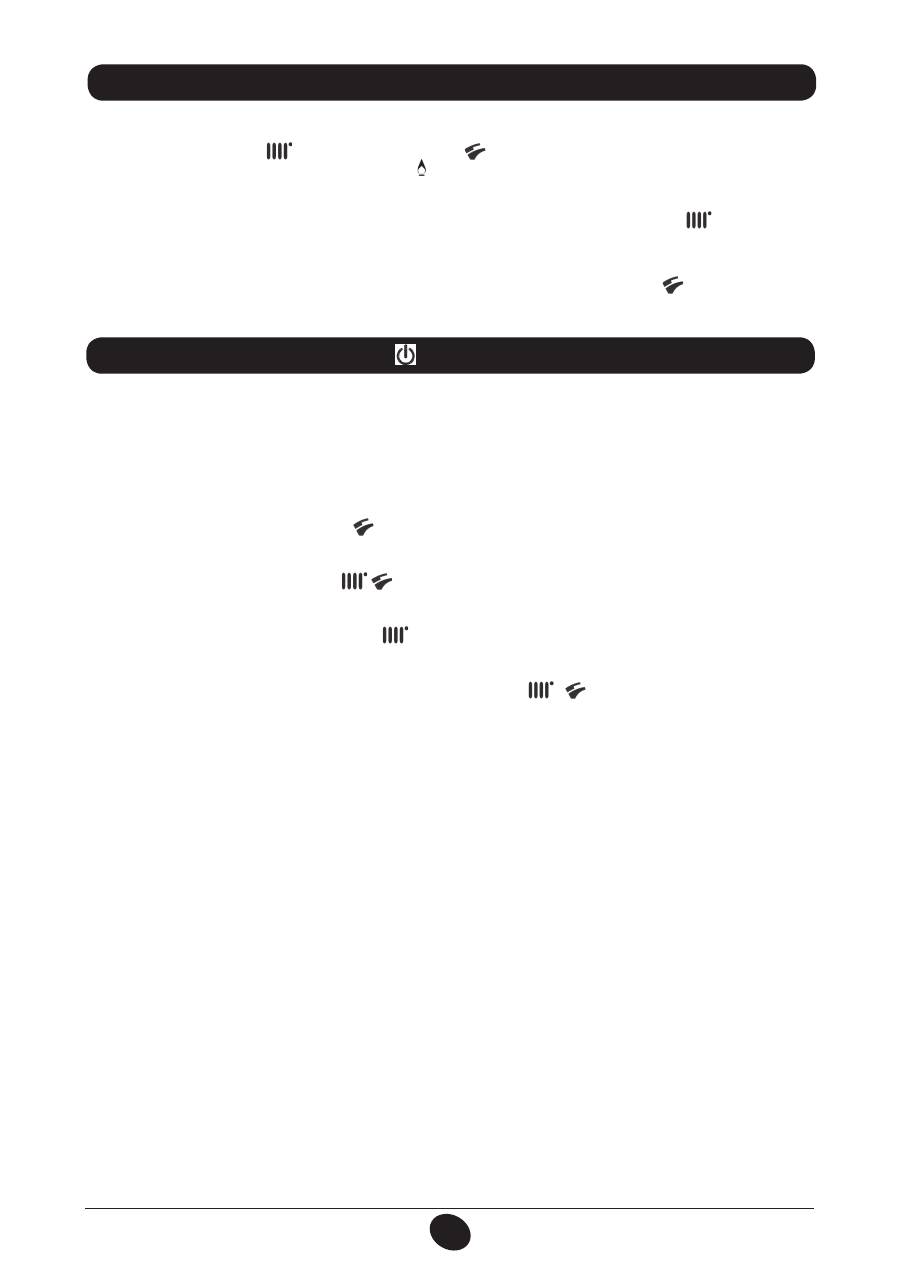
71
71.03982.03 - EN
OPERATING INSTRUCTIONS
4. ADJUSTING ROOM TEMPERATURE AND DHW TEMPERATURE
The system must be fitted with a room thermostat for controlling indoor temperature.
Adjust the room temperature (
) and the DHW temperature (
) by pressing the respective
+/-
(figure 1). The ignition
of the burner is shown on the display with the symbol ( ) as described in section 3.
HEATING
While the boiler is operating in the heating mode, the display (figure 1) shows the flashing symbol (
) and the heating
delivery temperature (°C).
DOMESTIC HOT WATER
While the boiler is operating in the DHW mode, the display (figure 1) shows the flashing symbol (
) and the DHW output
temperature (°C).
Press this button to set the following operating modes:
• SUMMER
• WINTER
• HEATING ONLY
• OFF
In the
SUMMER
mode, the display shows (
). The boiler satisfies requests for DHW only while central heating is NOT
enabled (ambient frost protection function active).
In the
WINTER
mode, the display shows (
). The boiler satisfies requests for both DHW and central heating (am-
bient frost protection function active).
In the
HEATING ONLY
mode, the display shows (
). The boiler satisfies requests for central heating only (ambient frost
protection function active).
In the
OFF
mode, the display shows neither of the above two symbols (
) (
). In this mode, only the ambient frost
protection function is active while requests for DHW and central heating are not satisfied.
5. DESCRIPTION OF BUTTON (Summer - Winter - Heating only - Off)

72
71.03982.03 - EN
OPERATING INSTRUCTIONS
To turn off the boiler, disconnect the electric power supply. In “OFF” mode (section 5) the boiler remains off (the display
indicates OFF) though the electrical circuits remain live and the frost protection device is enabled (section 9).
7. TURNING OFF THE BOILER 8. GAS CONVERSION
The boilers can operate both on natural gas and
LPG
.
All gas conversions must be made by an authorised Service Engineer.
WARNING
Disconnect the boiler from the mains power supply using the two-pole switch.
IMPORTANT:
Regularly check that the pressure displayed on the pressure gauge is 0.7 - 1.5 bar, with the boiler cold.
In case of overpressure, open the boiler drain tap. In case of insufficient temperature, open the boiler filling tap (figure 3).
Open the tap very slowly in order to vent the air.
6. FILLING THE SYSTEM
The boiler is fitted with a hydraulic pressure gauge which prevents the boiler from working if there is no water.
N.B.:
In case pressure drops occur frequently, have the boiler checked by an authorised Service Engineer.
Figure 2
A -
System drain tap
B
– Pressure gauge
C
- System filling tap
(supplied as an accessory for models 24 FF - 24)
D
– Disconnector
CG_2262 / 1007_2901
24 MI FF - 24 MI
24 FF - 24

73
71.03982.03 - EN
OPERATING INSTRUCTIONS
10. TROUBLESHOOTING
Do not drain the whole system as filling up with water again causes unnecessary and harmful scale to build up inside the
boiler and the heating elements. If the boiler is not used during winter and is therefore exposed to the danger of frost, add
some specific anti-freeze to the water in the system (e.g.: propylene glycol coupled with corrosion and scale inhibitors).
The electronic boiler management system includes a “frost protection” function for the heating system which, when delivery
temperature falls below 5°C, operates the burner until a delivery temperature of 30°C is reached.
The frost protection function is enabled if:
* the boiler is electrically powered;
* the gas tap is open;
* the system is at the correct pressure;
* the boiler is not blocked.
9. PROLONGED SHUTDOWN. FROST PROTECTION
N.B.:
in case of a fault, the display backlighting flashes together with the error code.
To keep the boiler efficient and safe, have it checked by the authorised Service Centre at the end of every operating period.
Careful servicing ensures economical operation of the system.
Do not clean the outer casing of the appliance with abrasive, aggressive and/or easily flammable cleaners (e.g.: petrol,
alcohol, and so on). Always switch off the appliance before cleaning it (see section 7 Switching off the boiler).
11. ROUTINE MAINTENANCE INSTRUCTIONS
Faults are shown on the display with an error code (e.g.: E 01):
CODE
DISPLAYED
FAULT
CORRECTIVE ACTION
E01
Failed ignition shutdown
Press and hold down “
R
” for at least 2 seconds. If this fault persists, call the
Authorised Service Centre.
E02
Safety thermostat tripped
Press and hold down “
R
” for at least 2 seconds. If this fault persists, call the
Authorised Service Centre.
E03
Flue thermostat/ flue pressure
switch tripped
Call the Authorised Service Centre.
E04
Shutdown after 6 consecutive
flame losses
Press and hold down “
R
” for at least 2 seconds. If this fault persists, call the
Authorised Service Centre.
E05
Flow sensor failure
Call the Authorised Service Centre.
E06
DHW sensor fault
Call the Authorised Service Centre.
E10
Hydraulic pressure switch
block
Check that the pressure in the system is correct; See section 6. If this fault
persists, call the Authorised Service Centre.
E25/E26
Probable blocked pump safety
trip
Call the Authorised Service Centre.
E35
Parasite flame (flame error)
Press and hold down “
R
” for at least 2 seconds. If this fault persists, call the
Authorised Service Centre.
E96
Switching off due to reductions
in power supply
RESET is automatic. If this fault persists, call the Authorised Service Centre
To RESET the boiler, press and hold down “R” for at
least 2 seconds. If this fault persists, call the Authorised
Service Centre.
N.B.:
5 reset attempts can be performed after which
the boiler shuts down. To reset again, switch off the
boiler for a few seconds.
Figure 3
0607_1205
RESETTABLE
faults
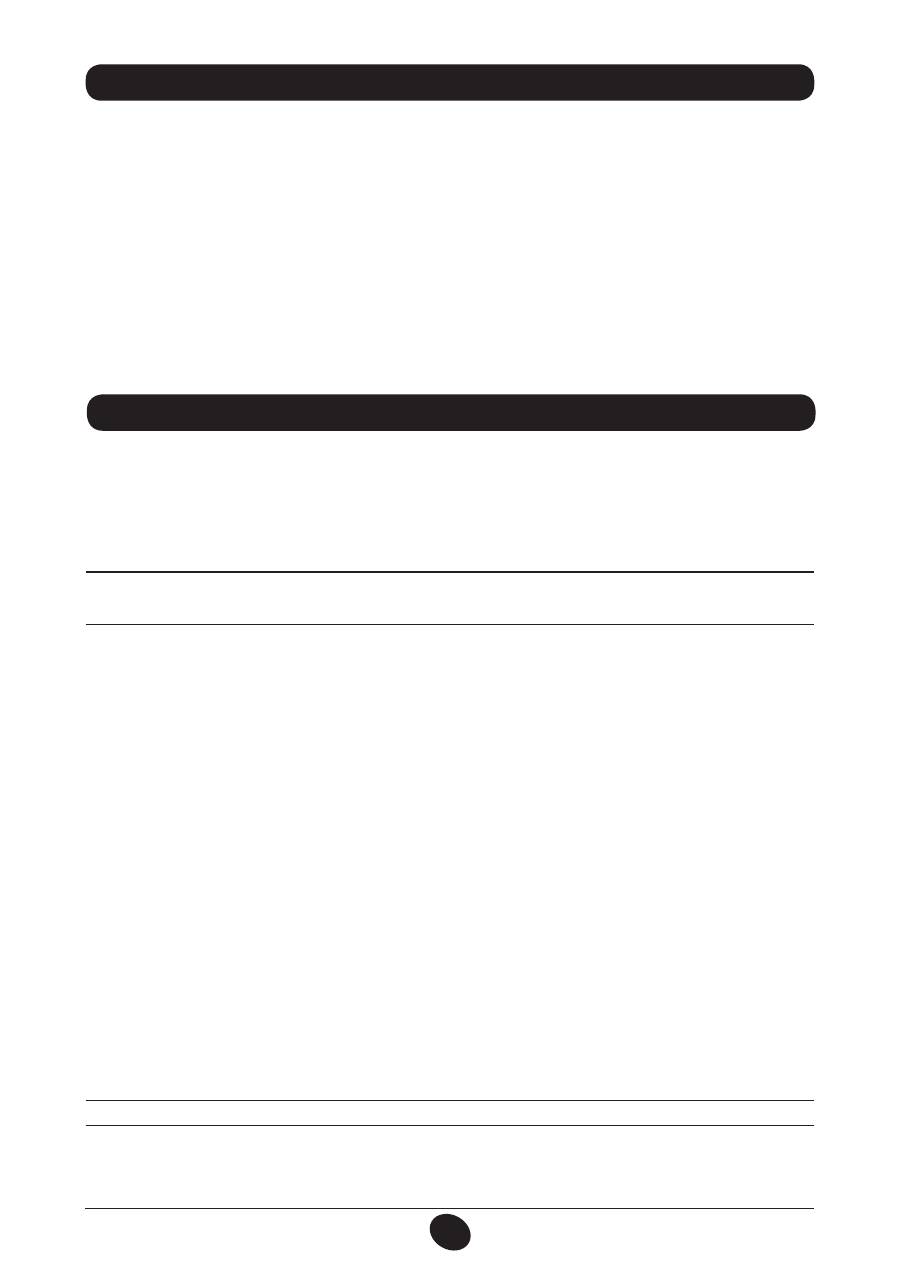
74
71.03982.03 - EN
INSTALLATION INSTRUCTIONS
This boiler has been designed to heat water to a temperature lower than boiling point at atmospheric pressure.
It must be connected to a central heating system and to a domestic hot water supply system according to its performance
and power output.
Do the following before connecting the boiler:
a) Make sure that the boiler is adjusted to use the type of gas delivered by the gas supply. To do this, check the markings
on the packaging and the rating plate on the appliance.
b) Make sure that the flue terminal draft is appropriate, that the terminal is not obstructed and that no exhaust gases
from other appliances are expelled through the same flue duct, unless the latter has been specially designed to collect
exhaust gas from more than one appliance, in compliance with current laws and regulations.
c) Make sure that, if the boiler is connected to existing flue ducts, these have been thoroughly cleaned as residual products
of combustion may detach from the walls during operation and obstruct the flow of fumes.
To ensure correct operation and maintain the warranty, observe the following precautions:
1. DHW circuit:
1.1.
If the water is harder than 20 °F (1 °F = 10 mg calcium carbonate per litre of water), install a polyphosphate dispenser
or an equivalent treatment system, compliant with current regulations.
1.2.
Thoroughly flush the system after installation of the appliance and before use.
1.3.
The materials used for the product’s DHW circuit comply with Directive 98/83/CE.
2. Heating circuit
2.1. new system
Before proceeding with installation of the boiler, the system must be cleaned and flushed to eliminate residual
thread-cutting swarf, solder and any solvents, using suitable proprietary products. To avoid damaging metal, plastic
and rubber parts, only use neutral cleaners, i.e. non-acid and non alkaline. Recommended cleaning products are:
SENTINEL X300 or X400 and FERNOX Regenerator for heating circuits. Use these products in strict compliance
with the manufacturers’ instructions.
2.2. existing system:
Before installing the boiler, drain the system and clean it to remove sludge and contaminants, using suitable
proprietary products as described in section 2.1.
To avoid damaging metal, plastic and rubber parts, use only neutral cleaners, i.e. non-acid and non-alkaline such
as SENTINEL X100 and FERNOX Protector for heating circuits. Use these products in strict compliance with the
manufacturers’ instructions.
Remember that the presence of foreign bodies in the heating system can adversely affect boiler operation (e.g.
overheating and excessive noise of the heat exchanger).
Failure to observe the above will render the warranty null and void
.
The following notes and instructions are addressed to fitters to allow them to carry out trouble-free installation. Instructions
for igniting and using the boiler are contained in the ‘Instructions for Users’ section.
• This boiler can be connected to any type of double- or single-pipe convector plate, radiator or thermoconvector. Design
the system sections as usual, though, bearing in mind the available flow-head at the plate, as shown in section 25.
• Do not leave any packaging (plastic bags, polystyrene, etc.) within reach of children, as it is a potential source of danger.
• Initial lighting of the boiler must be carried out by an authorised Service Engineer, as indicated on the attached sheet.
Failure to observe the above will render the guarantee null and void.
ADDITIONAL PUMP WARNING
If an additional pump is used on the heating system, position it on the boiler return circuit. This will allow the correct
operation of the water pressure switch.
SOLAR WARNING
if the instantaneous (mixed) boiler is connected to a system with solar panels, the maximum temperature of the domestic
hot water entering the boiler must not exceed
60°C
.
12. GENERAL INFORMATION 13. INSTRUCTIONS PRIOR TO INSTALLATION
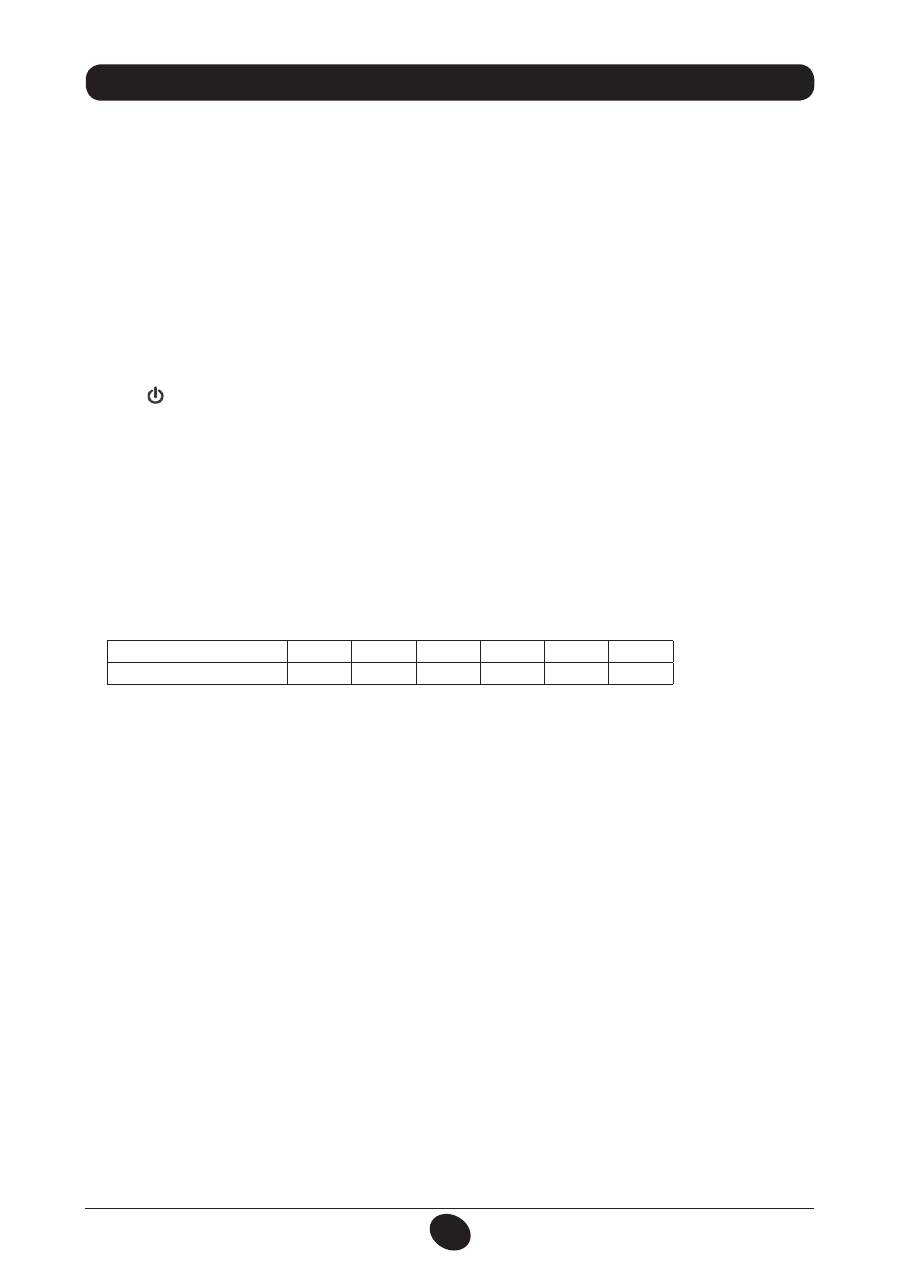
75
71.03982.03 - EN
INSTALLATION INSTRUCTIONS
13. INSTALLAZIONE DELLA CALDAIA 14. INSTALLING THE BOILER
After deciding the exact location of the boiler, make sure there is sufficient room to perform maintenance operations (at
least 450 mm of headroom is required in order to replace the expansion vessel).
Connect the system to the gas and water inlets present on the lower bar of the template. Fit two G3/4 taps (flow and
return) on the central heating circuit; these taps make it possible to carry out important operations on the system without
draining it completely. If you are either installing the boiler on an existing system or replacing one, as well as the above,
fit a settling tank under the boiler on the system return line in order to collect any deposits and scale circulating in the
system after flushing. After fixing the boiler to the template, connect the flue and air ducts, supplied as accessories, as
described in the following sections.
If the model
24 MI - 24
natural draught boiler is installed, connected it to the flue with a metal pipe resistant to normal
mechanical stress, heat, products of combustion and relative condensate.
IMPORTANT
After filling the boiler, vent the entire internal circuit and the system as follows:
• close the gas on-off valve;
• power the boiler.
• open the vent valve on the pump body;
• press (
) to set the boiler in the “WINTER” operating mode;
• send a heat demand from the room thermostat;
• open a hot water tap to alternate CH demand with DHW demand;
• after a few ignition attempts the boiler will shut down (error E01 appears on the display);
• to rest, press and hold down “
R
” for at least 2 seconds;
• repeat the procedure at least another two times;
• close the vent valve.
After venting the boiler circuit, proceed with initial lighting.
EXPANSION VESSEL
The boiler features a standard 6-litre expansion vessel with a pre-charge pressure of 1 bar. The maximum volume of water in
the system is calculated according to hydrostatic pressure at an average water temperature of 80°C (flow: 95°C return: 75°C).
Hydrostatic pressure (m)
5
6
7
8
9
10
Maximum system volume (l)
110
105
95
85
77
70
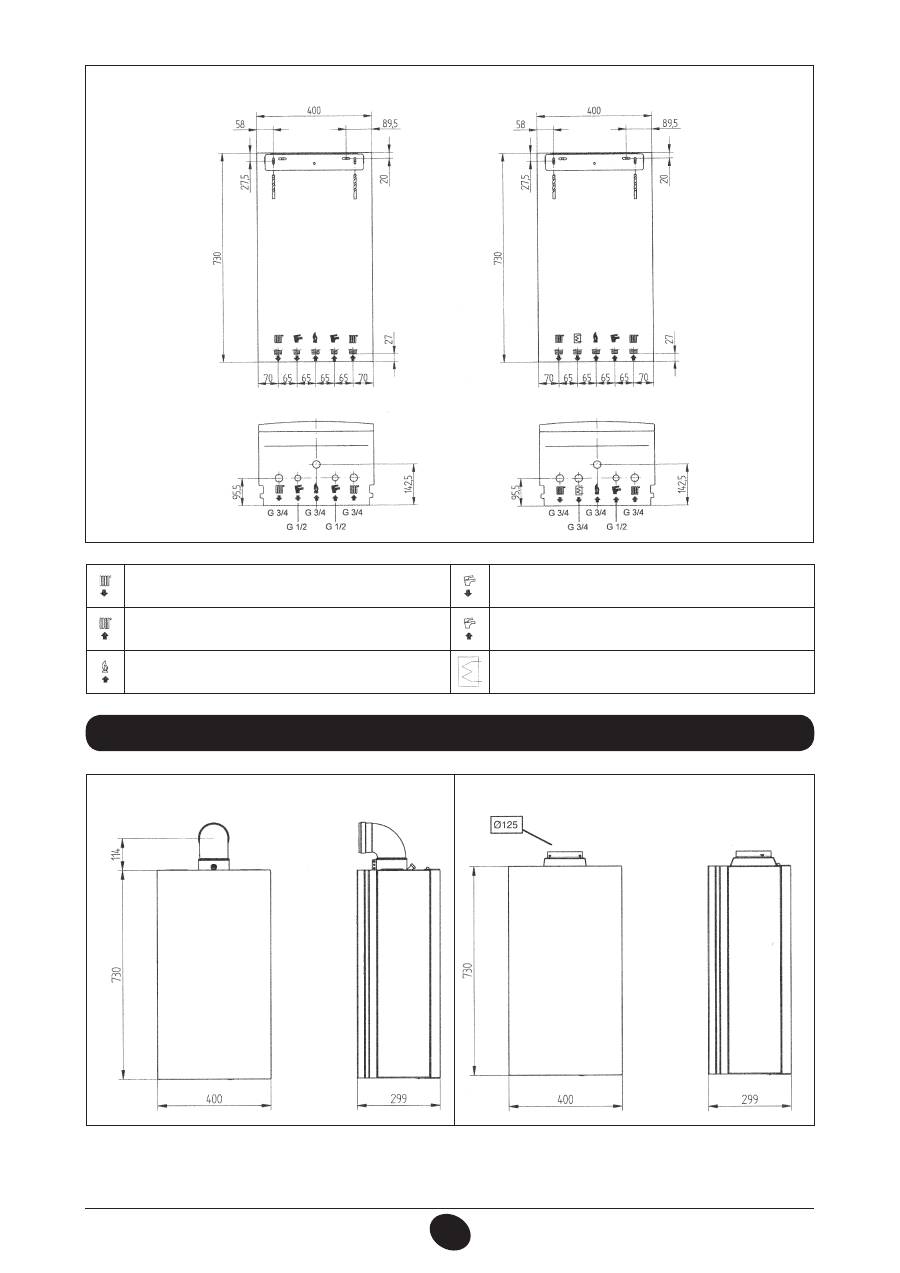
76
71.03982.03 - EN
INSTALLATION INSTRUCTIONS
14. DIMENSIONI CALDAIA 15. DIMENSIONS OF BOILER
Figure 5
24 FF - 24 MI FF
24 - 24 MI
CG_2009 / 1006_1802
CG_2009 / 1006_1803
G”3/4 HEATING FLOW
G”1/2 DOMESTIC HOT WATER OUTLET
G”3/4 HEATING RETURN
G”1/2 DOMESTIC COLD WATER INLET
G”3/4 GAS INLET TO BOILER
G”3/4 STORAGE BOILER COIL FLOW
WARNING
Tighten the boiler nipple water connections with care (maximum tightening torque 30 Nm).
Figure 4
24 MI - 24 MI FF
24 - 24 FF
CG_2263 / 1007_1403
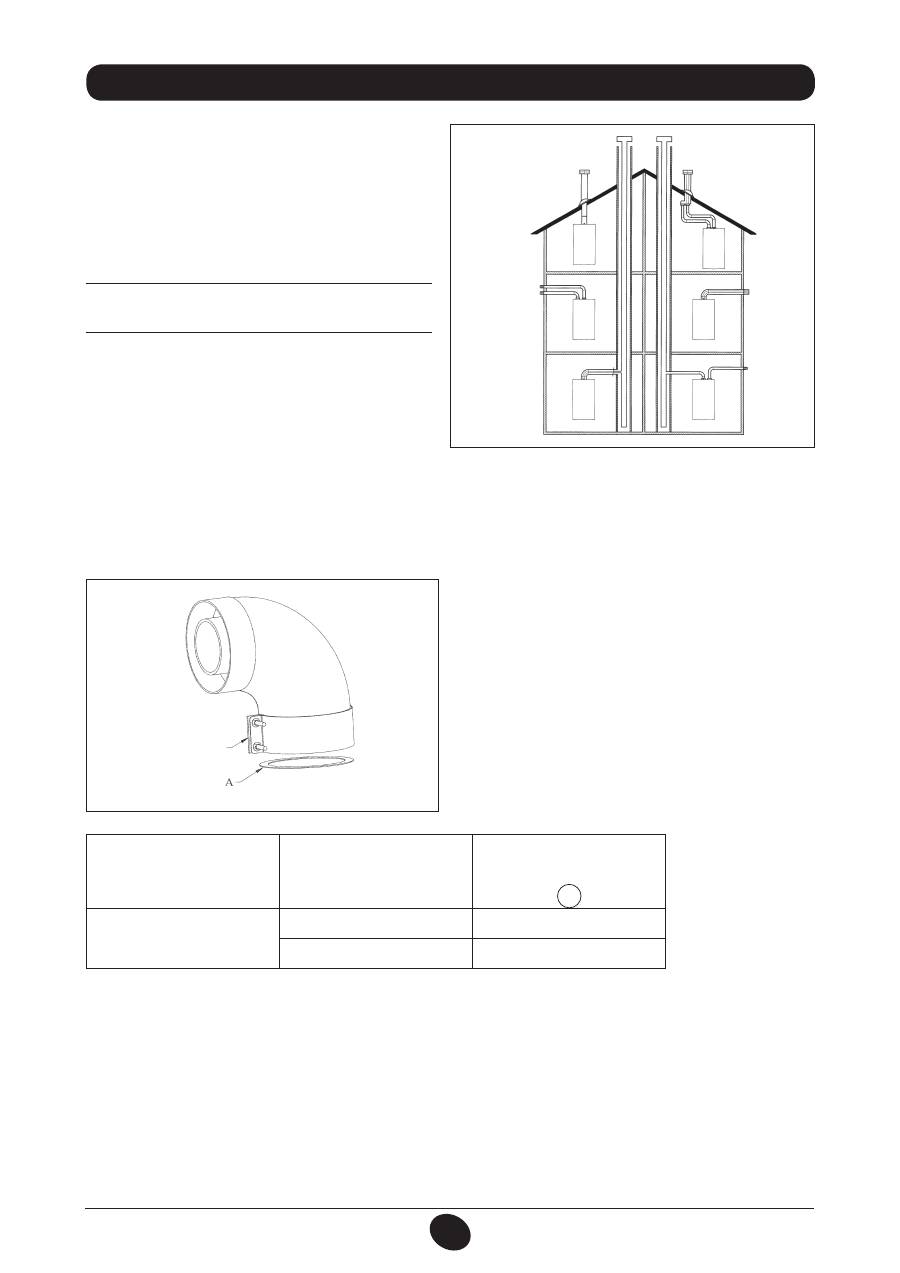
77
71.03982.03 - EN
INSTALLATION INSTRUCTIONS
16. INSTALLING THE FLUE AND AIR DUCTS
Model 24 MI FF - 24 FF
The boiler is easy and flexible to install thanks to the ex-
tensive range of available accessories, as described below.
The boiler has been designed for connection to a vertical
or horizontal coaxial flue-air duct. A splitting kit is also
available if separate ducts are required.
Only accessories supplied by the manufacturer must
be used for installation!
WARNING: To optimise operating safety, make sure
the flue ducts are firmly fixed to the wall with suitable
brackets.
Figure 6
0503_0905/CG1638
… COAXIAL FLUE-AIR DUCT (CONCENTRIC)
This type of duct is used to discharge exhaust fumes and draw combustion air both outside the building and if a LAS flue
is fitted.
The 90° coaxial curve allows the boiler to be connected to a flue-air duct in any direction as it can be rotated by 360°. It
can also be used as a supplementary curve combined with a coaxial duct or a 45° curve.
If fumes are discharged outside the building, the flue-air duct
must protrude at least 18 mm from the wall to allow an alu-
minium weathering surround to be fitted and sealed to avoid
water infiltrations.
Make sure there is a minimum upward slope towards the
outside of 1 cm per metre of duct.
•
A 90° curve reduces total duct length by 1 metre.
•
A 45° curve reduces total duct length by 0.5 metres.
The first 90° curve is not considered when calculating the
maximum available length.
Figure 7
0805_2901 / C
G_2073
Connector
Boiler model
Length (m)
Use of DIAPHRAGM
on INLET LINE
A
24 MI FF
24 FF
0 ÷ 1
Yes
1 ÷ 4
No
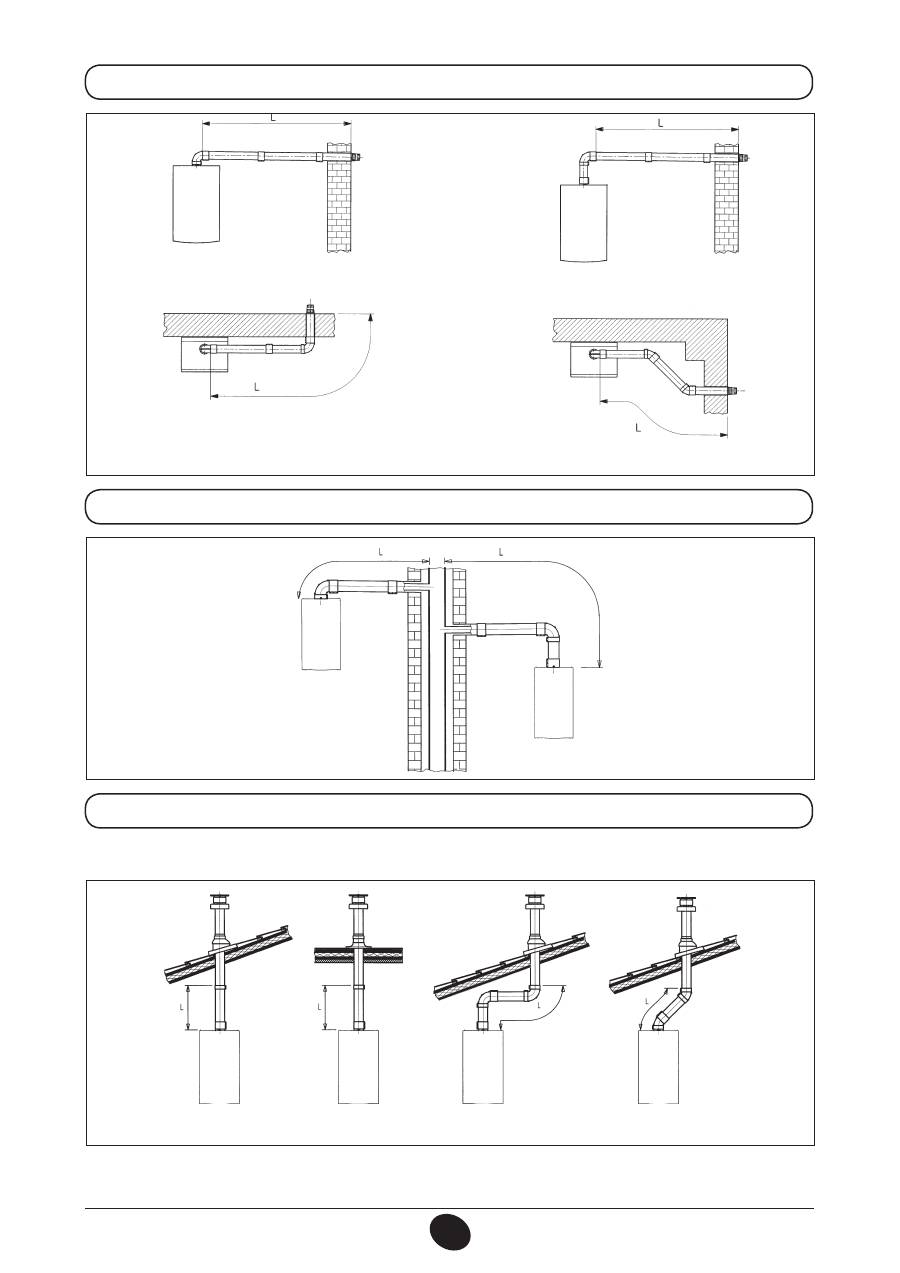
78
71.03982.03 - EN
INSTALLATION INSTRUCTIONS
16.1 HORIZONTAL FLUE INSTALLATION EXAMPLES
16.2 LAS FLUE DUCT INSTALLATION EXAMPLES C42 TYPE
16.3 VERTICAL FLUE INSTALLATION EXAMPLES
This type of installation can be carried out on either a flat or a pitched roof by fitting a flue terminal and a special weathering
surround with sleeve (both available on request).
0503_0908/CG1641
0503_0907/CG1640
0512_2001
For detailed installation instructions, consult the technical data provided with the accessories.
L max = 9 m (Ø 80/125 mm)
L max = 4 m (Ø 60/100 mm)
10 m (Ø 80/125 mm)
L max = 4 m (Ø 60/100 mm)
10 m (Ø 80/125 mm)
L max = 4 m (Ø 60/100 mm)
10 m (Ø 80/125 mm)
L max = 3 m (Ø 60/100 mm)
9 m (Ø 80/125 mm)
L max = 3 m (Ø 60/100 mm)
9 m (Ø 80/125 mm)
L max = 7 m (Ø 80/125 mm)
L max = 8 m (Ø 80/125 mm)
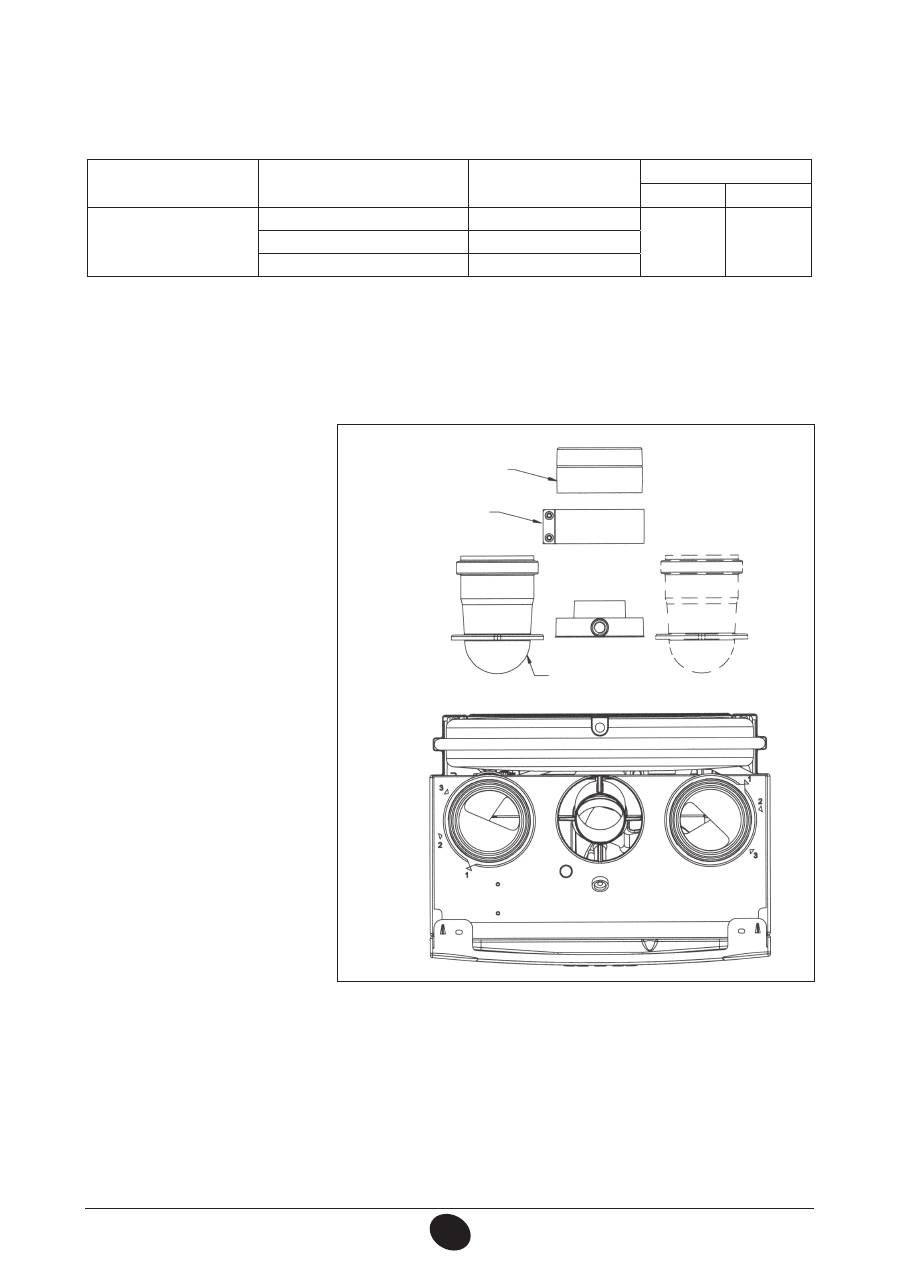
79
71.03982.03 - EN
INSTALLATION INSTRUCTIONS
… SEPARATE FLUE AND AIR DUCTS
This type of installation makes it possible to discharge exhaust fumes both outside the building and into single flue ducts.
Comburent air can be drawn in at a different location from that of the flue terminal. The splitting kit comprises a flue duct
adaptor (100/80) and an air duct adaptor. For the air duct adaptor, fit the screws and seals previously removed from the cap.
The 90° curve allows the boiler to be connected to a flue-air duct in any direction as it can be rotated by 360°. It can also
be used as a supplementary curve combined with a duct or a 45° curve.
• A 90° curve reduces total duct length by 0.5 metres.
• A 45° curve reduces total duct length by 0.25 metres.
The first 90° curve is not considered when calculating the maximum available length.
Boiler model
(L1+L2)
Position
of air regulator
CO
2
%
G20
G31
24 MI FF
24 FF
0 ÷ 4
1
7,2
8
4 ÷ 18
2
18 ÷ 30
3
Adjusting the air regulator for sepa-
rate flues
This regulator must be adjusted to
optimise combustion efficiency and
parameters.
After turning the air intake connecter,
which can be mounted both to the right
and the left of the exhaust flue duct,
suitably adjust the excess air according
to the total length of the combustion
exhaust and inlet flue ducts.
Turn this regulator anticlockwise to de-
crease the excess of comburent air and
vice-versa to increase it.
To fine tune, use a combustion product
analyser to measure the amount of CO
2
in the fumes at maximum heat capacity,
and, if a lower value is measured, gra-
dually adjust the air regulator until the
amount of CO
2
indicated in the following
table is measured.
To mount this device correctly, consult
the relative instructions
.
Figure 8
0809_0201 / CG_2045
Flue duct adaptor
Connector
Air intake restrictor
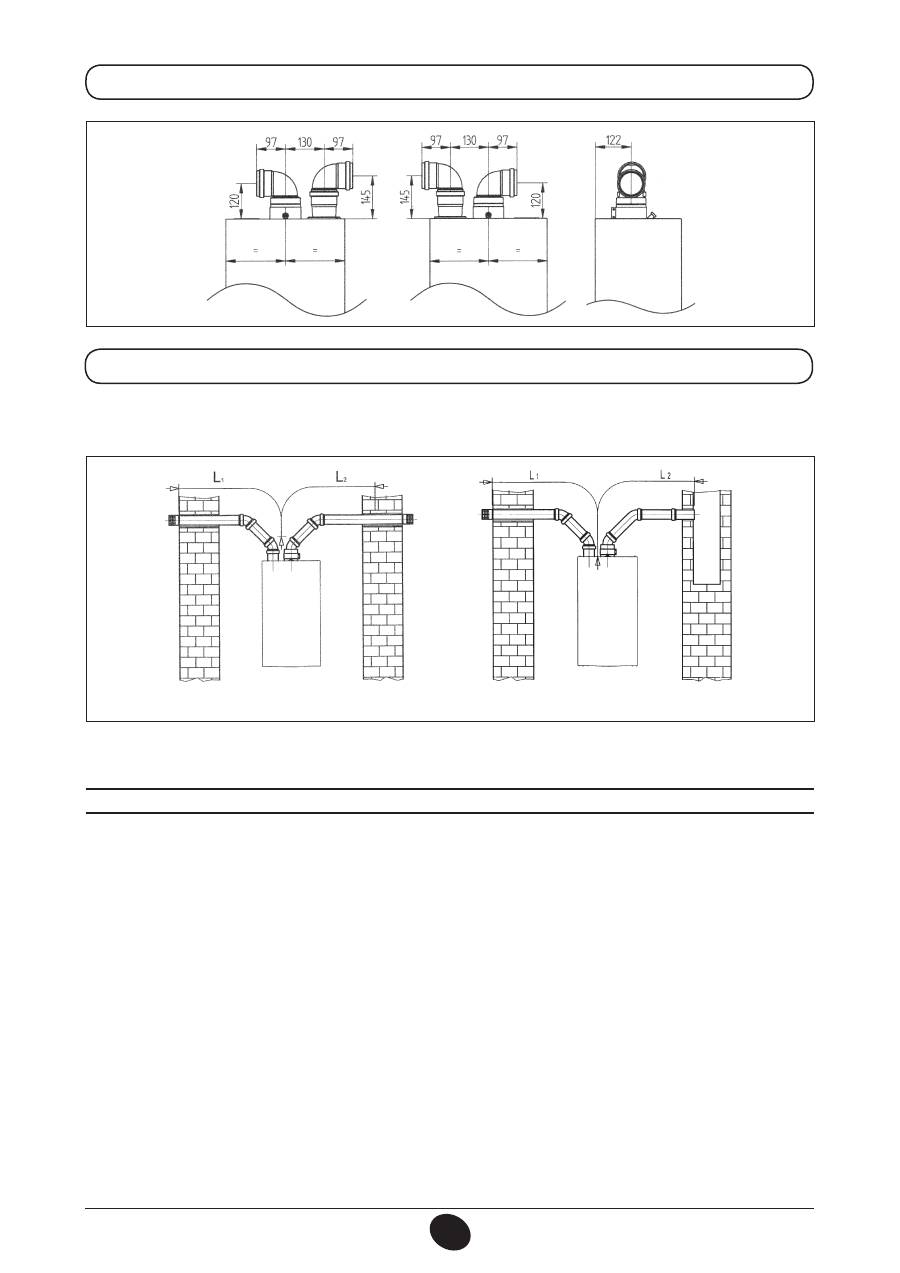
80
71.03982.03 - EN
INSTALLATION INSTRUCTIONS
16.5 HORIZONTAL SEPARATE FLUE INSTALLATION EXAMPLES - C82
IMPORTANT
-
Make sure there is a minimum downward slope towards the outside of 1 cm per metre of duct length.
In the event of installation of the condensate collection kit, the angle of the drain duct must be directed towards the boiler.
N.B.:
For the C52 type, do not fit the flue and air duct terminals on opposite walls of the building.
The inlet flue must have a maximum length of 10 metres for C52 fumes outlets.
If the discharge duct is longer than 6 metres, install the condensate collection kit, supplied as an accessory, near the boiler
16.4 DIMENSIONS OF SEPARATE OUTLETS
CG_2124 / 0905_2305
L max = 10 m
(L1 + L2) max = 30 m
1010_0102/CG1643
CG_1643_FR / 1010_0101
IMPORTANT:
if fitting a single flue duct, make sure it is adequately insulated (e.g.: with glass wool) wherever the duct
passes through building walls. For detailed installation instructions, consult the technical data provided with the accessories.
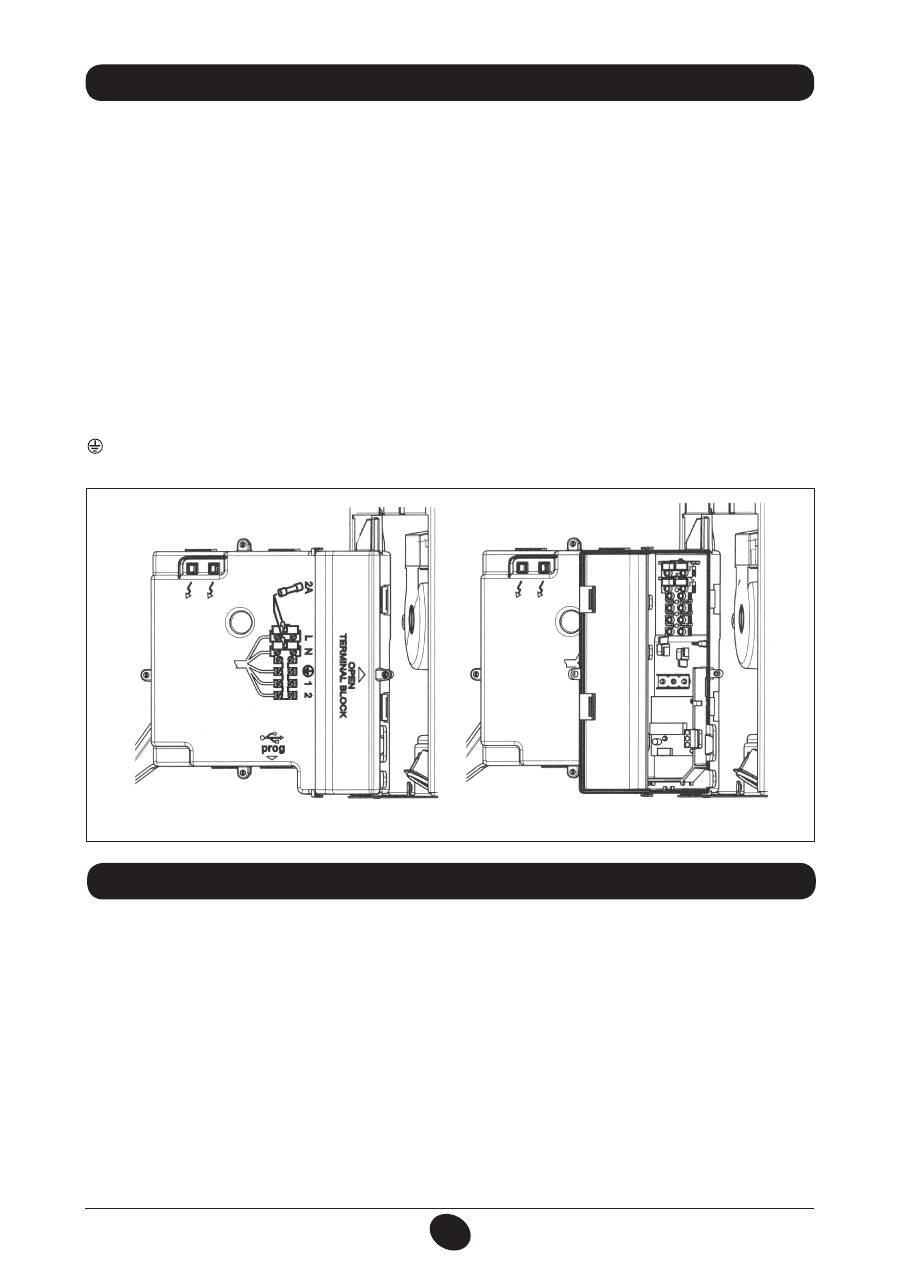
81
71.03982.03 - EN
INSTALLATION INSTRUCTIONS
17. ELECTRICAL CONNECTIONS 18. CONNECTING THE ROOM THERMOSTAT
• Access the power supply terminal block (figure 9) as described in the previous section;
• remove the jumper on terminals (1) and (2);
• thread the two-wire cable through the grommet and connect it to these two terminals.
This machine is only electrically safe if it is correctly connected to an efficient earth system in compliance with current
safety regulations.
Connect the boiler to a 230V single-phase earthed power supply using the supplied three-pin cable, observing correct
LIVE-NEUTRAL polarity.
Use a double-pole switch with a contact separation of at least 3 mm
. When replacing the power supply cable, fit a
harmonised HAR H05 VV-F’ 3x0.75mm
2
cable with a maximum diameter of 8 mm.
…Access to the power supply terminal block
• disconnect the boiler from the mains power supply using the two-pole switch;
• remove the two screws fixing the control panel to the boiler;
• rotate the control panel;
• remove the cover and access the wiring area (figure 9).
The 2A fast-blowing fuse is incorporated in the power supply terminal block (to check and/or replace the fuse, pull out
the black fuse carrier).
IMPORTANT:
respect polarity
L
(LIVE) -
N
(NEUTRAL).
(L) =
Live
(brown)
(N) =
Neutral
(blue)
=
Earth
(yellow-green)
(1) (2) =
Contact for room thermostat
CG_2008 / 1009_0301
Figure 9
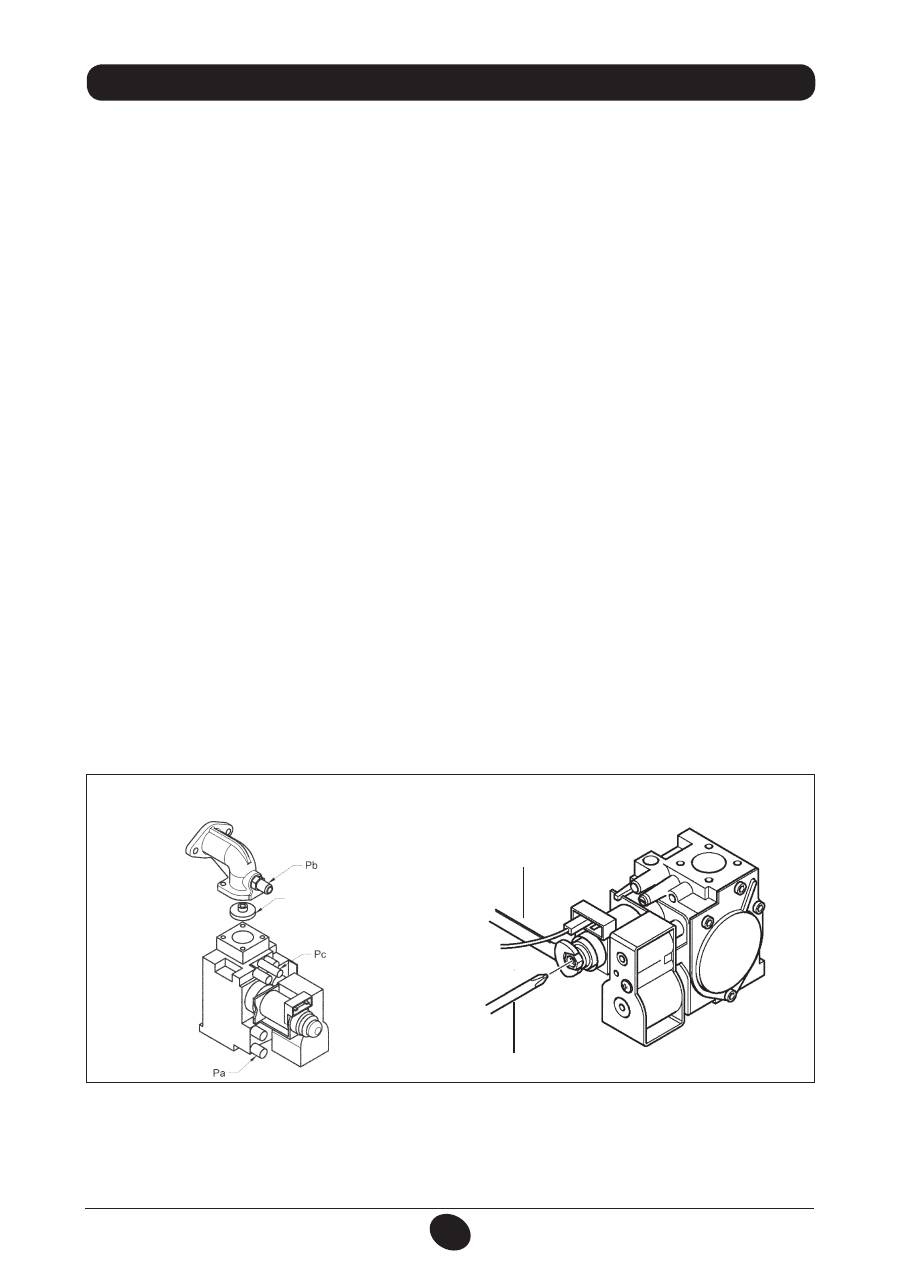
82
71.03982.03 - EN
INSTALLATION INSTRUCTIONS
19. GAS CONVERSION
The authorised Technical Assistance Service can convert this boiler to natural gas (
G. 20
) or liquid gas (
G.31
).
Carry out the following operations:
A) replace the nozzles of the main burner and the gas diaphragm (if fitted);
B) new max. and min. calibration of the pressure regulator.
A) Replace the burner nozzles
• carefully pull the main burner off its seat;
• replace the main burner nozzles making sure to fully tighten them to prevent gas leaks. Nozzle diameters are specified
in table 2.
B) Calibrate the pressure regulator
• connect the positive pressure test point of a differential pressure gauge (possibly water-operated) to the gas valve
pressure test point (
Pb
) (Figure 10). Only for models with sealed chambers, connect the negative pressure test point of
the manometer to a “T” fitting in order to join the boiler adjustment outlet, the gas valve adjusting outlet (Pc) and the
pressure gauge. (The same measurement can be made by connecting the pressure gauge to the pressure test point
(
Pb
) after removing the front panel of the sealed chamber);
Measuring burner pressure using methods other than those described could lead to incorrect results as the low pressure
created by the fan in the sealed chamber would not be taken into account.
B1) Adjustment to nominal heat output:
• open the gas tap and switch the boiler to the Winter mode;
• open a hot water tap that can provide a flow rate of at least 10 litres a minute or make sure there is maximum heat
demand;
• remove the modulator cover;
• adjust the tube brass screw (a) until the pressure values shown in table 1 are obtained;
make sure that the dynamic inlet pressure of the boiler, measured at the gas valve pressure test point (Pa) (Figure 10) is
correct (37 mbar for propane or 20 mbar for natural gas).
B2) Adjustment to reduced heat output:
• disconnect the modulator power cable and unscrew the screw (b) until a pressure value corresponding to reduced heat
output is achieved (see tab. 1);
• reconnect the cable;
• mount the modulator cover and seal.
B3) Final checks
• attach the additional plate supplied with the transformer, specifying the type of gas and the calibration performed.
Figure 10
gas valve
mod. SIGMA 845
b
a
0605_1502
Figure 11
CG_2273 / 1008_2602
gas diaphragm
ATTENTION
If the natural gas inlet pressure is too low (less than 17 mbar) remove the gas diaphragm installed over the gas valve (fig.
10) and set parameter
F02=00
on the electronic board (§21).
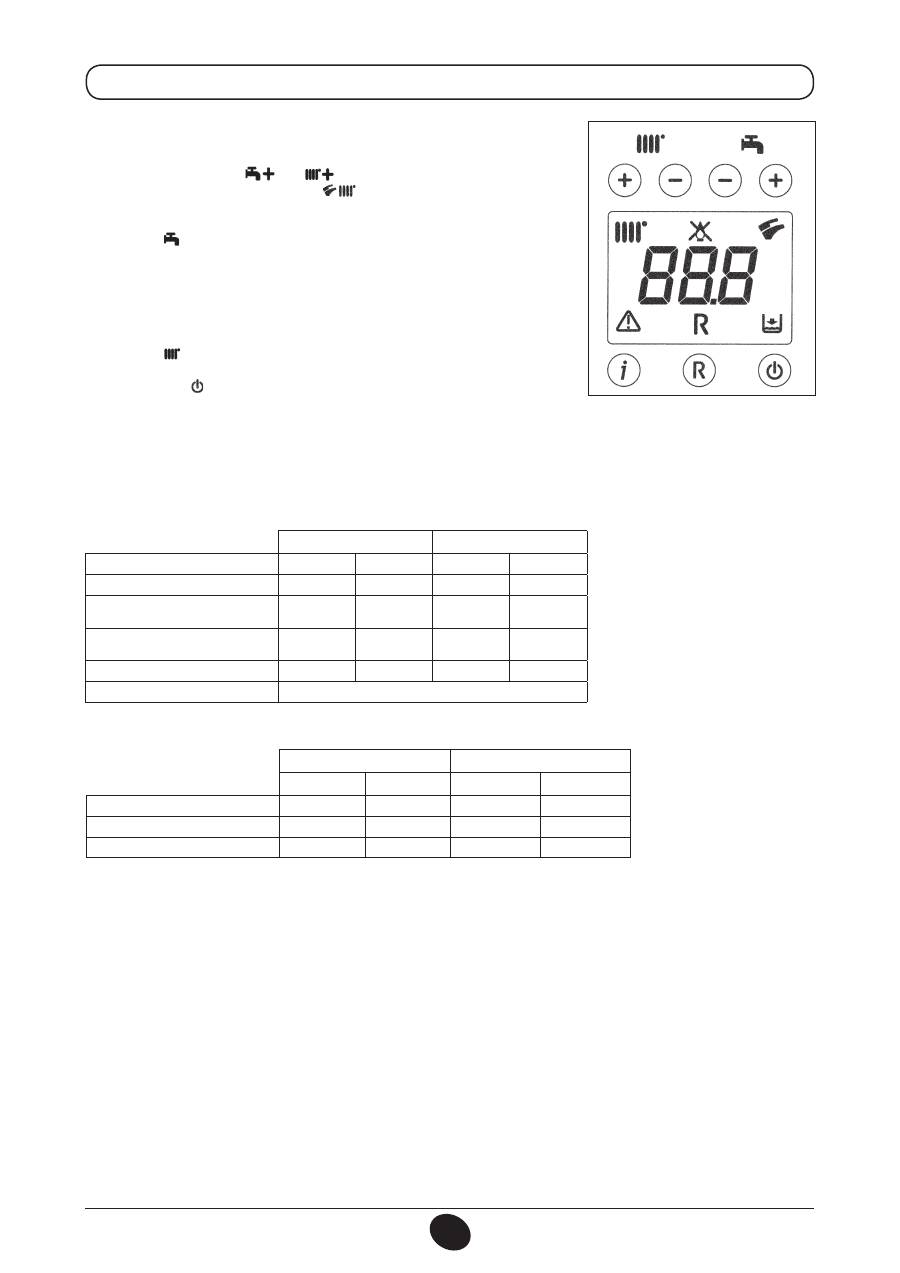
83
71.03982.03 - EN
INSTALLATION INSTRUCTIONS
19.1 GAS VALVE CALIBRATION FUNCTION
Note:
The function is automatically deactivated after a period of 15 minutes, at the end of which the electronic board returns to
its operating status prior to the activation of the function or prior to reaching the set maximum temperature.
To simplify calibration of the gas valve, the calibration function may be set directly
on the boiler control panel as follows:
a)
hold down the buttons
and
together for at least 6 seconds;
b)
after about 6 seconds, the symbols
flash;
c)
the display shows, at intervals of one second, “
100
” and the
flow temperature
.
In this phase, the boiler works at the maximum heating output (100%).
d)
press
+/-
to immediately set the power of the boiler (100% or 0%);
e)
adjust the
“Pmax/Pmin”
screw (figure 10) to set the burner pressure value as
described in table 1.
To adjust pressure at maximum power, turn the “
Pmax
” screw (fig. 10) clockwise
to increase or anti-clockwise to decrease pressure at the burner.
To adjust pressure at minimum power, turn the “
Pmin
” screw (fig. 10) clockwise
to increase or anti-clockwise to decrease pressure at the burner.
f)
press
+/-
to gradually set the desired power level (interval = 1%).
Press the button to leave the function.
0805_2302 / 1002_1201
Consumption 15°C-1013 mbar
24 MI FF - 24 FF
24 - 24 MI
G20
G31
G20
G31
Rated power
2,80 m
3
/h
2,00 kg/h
2,80 m
3
/h
2,04 kg/h
Reduced power
1,12 m
3
/h
0,82 kg/h
1,12 m
3
/h
0,82 kg/h
p.c.i.
34,02 MJ/m
3
46,34 MJ/kg
34,02 MJ/m
3
46,34 MJ/kg
Table 2
* 1 mbar = 10,197 mmH
2
O
Table of burner nozzles
24 MI FF - 24 FF
24 - 24 MI
gas type
G20
G31
G20
G31
diameter of nozzles (mm)
1,28
0,77
1,18
0,77
Burner pressure (mbar*)
REDUCED HEAT OUTPUT
2,0
5,7
2,4
5,6
Burner pressure (mbar*)
RATED HEAT OUTPUT
11,6
32,6
13,8
31,0
Diameter of gas diaphragm (mm)
4,8
—
5,5
—
N° nozzles
13
Table 1
Оглавление
- SOMMAIRE
- 5. DESCRIPTION DES TOUCHES (ÉTÉ – HIVER – CHAUFFAGE SEULEMENT – ARRÊT)
- •
- 28. RACCORDEMENT D’UN BALLON SEPARE AVEC UN MOTEUR VANNE 3 VOIES
- 5. DESCRIZIONE TASTO (Estate - Inverno - Solo riscaldamento - Spento)
- •
- 5. DESCRIPTION OF BUTTON (Summer - Winter - Heating only - Off)
- •
- 5. DESCRIPCIÓN DE LA TECLA (Verano - Invierno - Sólo calefacción - Apagado)
- •
- 5. ОПИСАНИЕ НА БУТОН (Лято – Зима – Само отопление – Изключен)
- 8. СМЯНА НА ВИДА ГАЗ
- 13. УКАЗАНИЯ ПРЕДИ МОНТАЖА
- 15. РАЗМЕРИ НА КОТЕЛА
- •
- 28. ГОДИШЕН ПРЕГЛЕД
- SPIS TREŚCI
- 1. OSTRZEŻENIA PRZED ZAINSTALOWANIEM
- 3. ROZRUCH KOTŁA
- 4. REGULACJA TEMPERATURY POKOJOWEJ I CIEPŁEJ WODY UŻYTKOWEJ
- 7. WYŁĄCZENIE KOTŁA 8. ZMIANA GAZU
- 9. WYDŁUŻONY OKRES WYŁĄCZENIA INSTALACJI. OCHRONA PRZED ZAMARZANIEM
- 12. UWAGI OGÓLNE 13. WYMAGANIA INSTALACYJNE
- 14. UWAGI INSTALACYJNE
- 15. WYMIARY KOTŁA
- 16. INSTALOWANIE PRZEWODÓW POWIETRZNO-SPALINOWYCH
- 17. PODŁĄCZENIE ELEKTRYCZNE 18. PODŁĄCZENIE TERMOSTATU POKOJOWEGO
- 19. SPOSÓB ZMIANY RODZAJU GAZU
- •
- 21. USTAWIENIE PARAMETRÓW
- 23. USTAWIENIE ELEKTRODY ZAPŁONOWEJ I JONIZACYJNEJ PŁOMIEŃ
- 24. KONTROLA PARAMETRÓW SPALANIA 25. CHARAKTERYSTYKA NATĘŻENIA PRZEPŁYWU/WYSOKOŚCI PODNOSZENIA
- 26. PODŁĄCZENIE CZUJNIKA ZEWNĘTRZNEGO
- 28. KONSERWACJA ROCZNA
- 30. CZYSZCZENIE FILTRÓW
- 32. DEMONTAŻ WYMIENNIKA WODA-WODA
- 33. SCHEMAT FUNKCJONALNY OBWODÓW
- 34. SCHEMAT POŁACZEŃ ELEKTRYCZNYCH
- 35. CHARAKTERYSTYKA TECHNICZNA
- CUPRINS
- 1. AVERTISMENTE ANTERIOARE INSTALĂRII
- 3. PUNEREA ÎN FUNCŢIUNE A CENTRALEI TERMICE
- 4. REGLAREA TEMPERATURII AMBIANTE ŞI A TEMPERATURII APEI MENAJERE
- 7. OPRIREA CENTRALEI TERMICE 8. SCHIMBAREA TIPULUI DE GAZ
- 10. INTRAREA ÎN FUNCŢIUNE A DISPOZITIVELOR DE SIGURANŢA
- 12. AVERTISMENTE GENERALE 13. AVERTISMENTE ANTERIOARE INSTALĂRII
- 13. INSTALLAZIONE DELLA CALDAIA 14. INSTALAREA CENTRALEI TERMICE
- 14. DIMENSIONI CALDAIA 15. DIMENSIUNILE CENTRALEI TERMICE
- 16. INSTALAREA CONDUCTELOR DE EVACUARE GAZE ARSE ŞI ADMISIE AER
- 17. CONECTAREA LA REŢEAUA ELECTRICĂ 18. CONECTAREA TERMOSTATULUI AMBIENTAL
- 19. MODALITĂŢI DE SCHIMBARE A TIPULUI DE GAZ
- 20. VIZUALIZAREA PARAMETRILOR PE AFIŞAJ (FUNCŢIE “INFO”)
- 21. SETAREA PARAMETRILOR
- 23. POZIŢIONAREA ELECTRODULUI DE APRINDERE ŞI DETECTARE A FLĂCĂRII
- 24. VERIFICAREA PARAMETRILOR DE COMBUSTIE 25. PERFORMANŢE DEBIT/ÎNĂLŢIME DE POMPARE
- 26. CONECTAREA SONDEI EXTERNE
- 28. ÎNTREŢINEREA ANUALĂ
- 30. CURĂŢAREA FILTRELOR
- 32. DEMONTAREA SCHIMBĂTORULUI APĂ-APĂ
- 33. DIAGRAMĂ FUNCŢIONALĂ CIRCUITE
- 34. DIAGRAMĂ CUPLARE CONECTORI
- 35. CARACTERISTICI TEHNICE
- ΠΕΡΙΕΧΟΜΕΝΑ
- 1. ΟΔΗΓΙΕΣ ΠΡΙΝ ΤΗΝ ΕΓΚΑΤΑΣΤΑΣΗ
- 3. ΘΕΣΗ ΣΕ ΛΕΙΤΟΥΡΓΙΑ ΤΟΥ ΛΕΒΗΤΑ
- 4. ΡΥΘΜΙΣΗ ΤΗΣ ΘΕΡΜΟΚΡΑΣΙΑΣ ΠΕΡΙΒΑΛΛΟΝΤΟΣ ΚΑΙ ΤΟΥ ΝΕΡΟΥ ΟΙΚΙΑΚΗΣ ΧΡΗΣΗΣ
- 7. ΣΒΗΣΙΜΟ ΤΟΥ ΛΕΒΗΤΑ 8. ΑΛΛΑΓΗ ΑΕΡΙΟΥ
- 10. ΕΝΔΕΙΞΕΙΣ-ΕΠΕΜΒΑΣΗ ΣΥΣΤΗΜΑΤΩΝ ΑΣΦΑΛΕΙΑΣ
- 12. ΓΕΝΙΚΕΣ ΠΛΗΡΟΦΟΡΙΕΣ 13. ΟΔΗΓΙΕΣ ΠΡΙΝ ΤΗΝ ΕΓΚΑΤΑΣΤΑΣΗ
- 13. INSTALLAZIONE DELLA CALDAIA 14. ΕΓΚΑΤΑΣΤΑΣΗ ΤΟΥ ΛΕΒΗΤΑ
- 14. DIMENSIONI CALDAIA 15. ΔΙΑΣΤΑΣΕΙΣ ΛΕΒΗΤΑ
- 16. ΕΓΚΑΤΑΣΤΑΣΗ ΑΓΩΓΩΝ ΑΠΑΓΩΓΗΣ - ΑΝΑΡΡΟΦΗΣΗΣ
- 17. ΗΛΕΚΤΡΙΚΗ ΣΥΝΔΕΣΗ 18. ΣΥΝΔΕΣΗ ΤΟΥ ΘΕΡΜΟΣΤΑΤΗ ΔΩΜΑΤΙΟΥ
- 19. ΤΡΟΠΟΣ ΑΛΛΑΓΗΣ ΑΕΡΙΟΥ
- 20. ΑΠΕΙΚΟΝΙΣΗ ΠΑΡΑΜΕΤΡΩΝ ΣΤΗΝ ΟΘΟΝΗ (ΛΕΙΤΟΥΡΓΙΑ «INFO»)
- 21. ΡΥΘΜΙΣΗ ΠΑΡΑΜΕΤΡΩΝ
- 23. ΤΟΠΟΘΕΤΗΣΗ ΗΛΕΚΤΡΟΔΙΟΥ ΑΝΑΦΛΕΞΗΣ ΚΑΙ ΑΝΙΧΝΕΥΣΗΣ ΦΛΟΓΑΣ
- 24. ΕΛΕΓΧΟΣ ΠΑΡΑΜΕΤΡΩΝ ΚΑΥΣΗΣ 25. ΧΑΡΑΚΤΗΡΙΣΤΙΚΑ ΠΑΡΟΧΗΣ / ΜΑΝΟΜΕΤΡΙΚΟΥ ΥΨΟΥΣ ΣΤΗΝ ΠΛΑΚΑ
- 26. ΣΥΝΔΕΣΗ ΤΟΥ ΕΞΩΤΕΡΙΚΟΥ ΑΙΣΘΗΤΗΡΑ
- 28. ΕΤΗΣΙΑ ΣΥΝΤΗΡΗΣΗ
- 30. ΚΑΘΑΡΙΣΜΟΣ ΤΩΝ ΦΙΛΤΡΩΝ
- 32. ΑΠΟΣΥΝΑΡΜΟΛΟΓΗΣΗ ΕΝΑΛΛΑΚΤΗ ΝΕΡΟΥ-ΝΕΡΟΥ
- 33. ΛΕΙΤΟΥΡΓΙΚΟ ΣΧΕΔΙΟ ΚΥΚΛΩΜΑΤΩΝ
- 34. ΣΧΕΔΙΟ ΣΥΝΔΕΣΗΣ ΣΥΝΔΕΣΜΩΝ
- 35. ТЕХНИЧЕСКИ ХАРАКТЕРИСТИКИ
- 5. ОПИСАНИЕ КНОПКИ (Лето – Зима – Только Отопление – Выключено)
- •
- 5. 锅炉运行模式选择
- 错误信息及故障表

